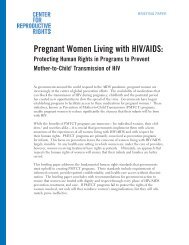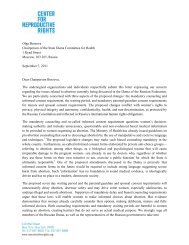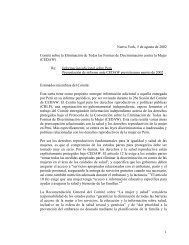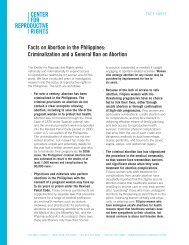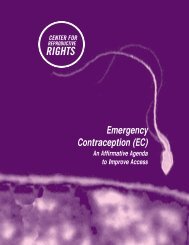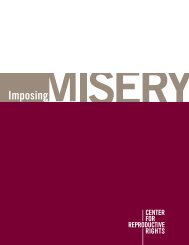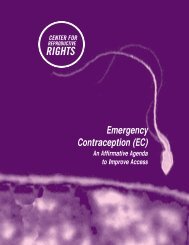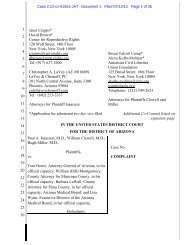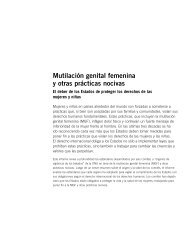CRR Annual Report 2009 - Center for Reproductive Rights
CRR Annual Report 2009 - Center for Reproductive Rights
CRR Annual Report 2009 - Center for Reproductive Rights
You also want an ePaper? Increase the reach of your titles
YUMPU automatically turns print PDFs into web optimized ePapers that Google loves.
State legislatures across the<br />
United States keep coming<br />
up with ever more insidious<br />
tactics to intimidate women who<br />
seek abortions and curb their<br />
access to essential reproductive<br />
healthcare services.<br />
This hypothetical may sound absurd, but relentless antichoice<br />
assaults on access to abortion services make it a<br />
reality <strong>for</strong> many women who seek reproductive healthcare.<br />
The consequences of these and similar restrictions<br />
can be harrowing.<br />
Just ask the terrified domestic violence victim in Arizona<br />
who needlessly risks a second trip to an abortion clinic—<br />
and being found out by her partner—because of an<br />
unnecessary waiting period. Or the Oklahoma woman<br />
who has made the excruciating decision to terminate<br />
a wanted pregnancy because it poses a threat to her<br />
health, but is <strong>for</strong>ced to have an ultrasound she neither<br />
needs nor wants and then listen to her doctor describe<br />
the image in detail be<strong>for</strong>e being able to have an abortion.<br />
State legislatures across the United States keep coming<br />
up with ever more insidious tactics to intimidate women<br />
who seek abortions, including cumbersome waiting<br />
periods, intrusive reporting burdens, biased counseling<br />
rules, unnecessary ultrasound requirements, and<br />
parental notification laws. In <strong>2009</strong>, the <strong>Center</strong> filed legal<br />
challenges to five such anti-choice measures across the<br />
United States.<br />
A few of these abortion restrictions may seem innocuous<br />
at first glance, but their true purpose is to stigmatize<br />
abortion and make it difficult if not impossible to obtain.<br />
Rarely, if ever, do lawmakers address the real-life consequences<br />
of making abortion unavailable.<br />
Women in Arizona, however, were more than willing to<br />
tell us about these consequences as we gathered their<br />
testimonies <strong>for</strong> our lawsuit against the state’s new twentyfour-hour<br />
waiting period. Those we interviewed described<br />
how they are <strong>for</strong>ced to travel extraordinary distances<br />
to reach an abortion clinic, borrow money, leave bills<br />
unpaid, and give up wages to make just one trip. If they<br />
had needed to make a second trip, as is now required by<br />
the new law, some of them would have never been able<br />
to obtain an abortion. Women in abusive relationships<br />
would be put at greater risk of being discovered by their<br />
partners. As one woman told us about her boyfriend, “If<br />
he knew I was here, he would probably kill me.”<br />
Fending off these nightmarish scenarios is why we fight<br />
<strong>for</strong> women’s rights. In a case we filed in <strong>2009</strong>, a North<br />
Dakota judge clarified that the state’s only abortion clinic<br />
did not need to buy expensive medical equipment to<br />
make the fetal heart tone audible during an ultrasound—<br />
avoiding a costly requirement that could have shut down<br />
the clinic.<br />
In Oklahoma, we defeated two outrageous measures: an<br />
extreme ultrasound law that <strong>for</strong>ced all women obtaining<br />
abortions to first have an ultrasound and listen to their<br />
doctors describe the image, and a bill that obliged doctors<br />
to essentially interrogate women about their reasons<br />
<strong>for</strong> seeking an abortion. This latter measure required<br />
women to answer questions about whether their romantic<br />
relationships or financial problems contributed to their<br />
decision to have an abortion, as well as to provide their<br />
age, race, marital status, education level, and method of<br />
payment. Data collected from these questionnaires would<br />
have been posted on a public website.<br />
But anti-choice lawmakers are single-minded in pursuing<br />
their agenda. In the spring of 2010, the Oklahoma<br />
legislature once again passed the same ultrasound and<br />
reporting requirements that state courts struck down,<br />
with only slight technical changes. Our <strong>for</strong>midable legal<br />
team stood ready, immediately filing a new challenge<br />
against the ultrasound measure. We know the opposition’s<br />
tactics well, and we know that we must be vigilant<br />
and quick to respond. Access <strong>for</strong> millions of women to<br />
a meaningful system of reproductive health and rights<br />
depends on nothing less.<br />
34



